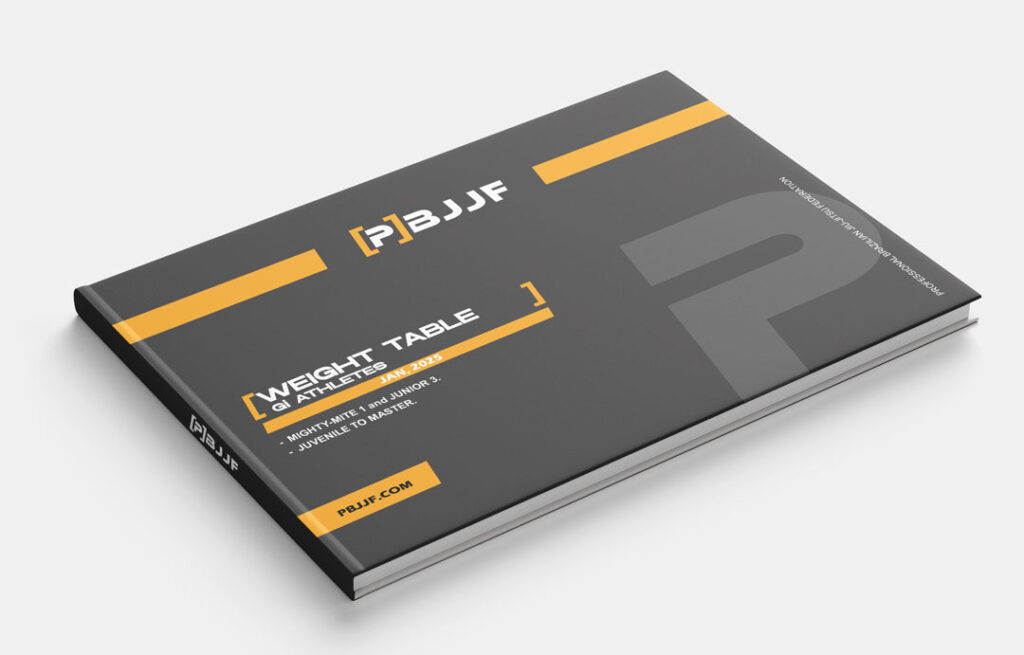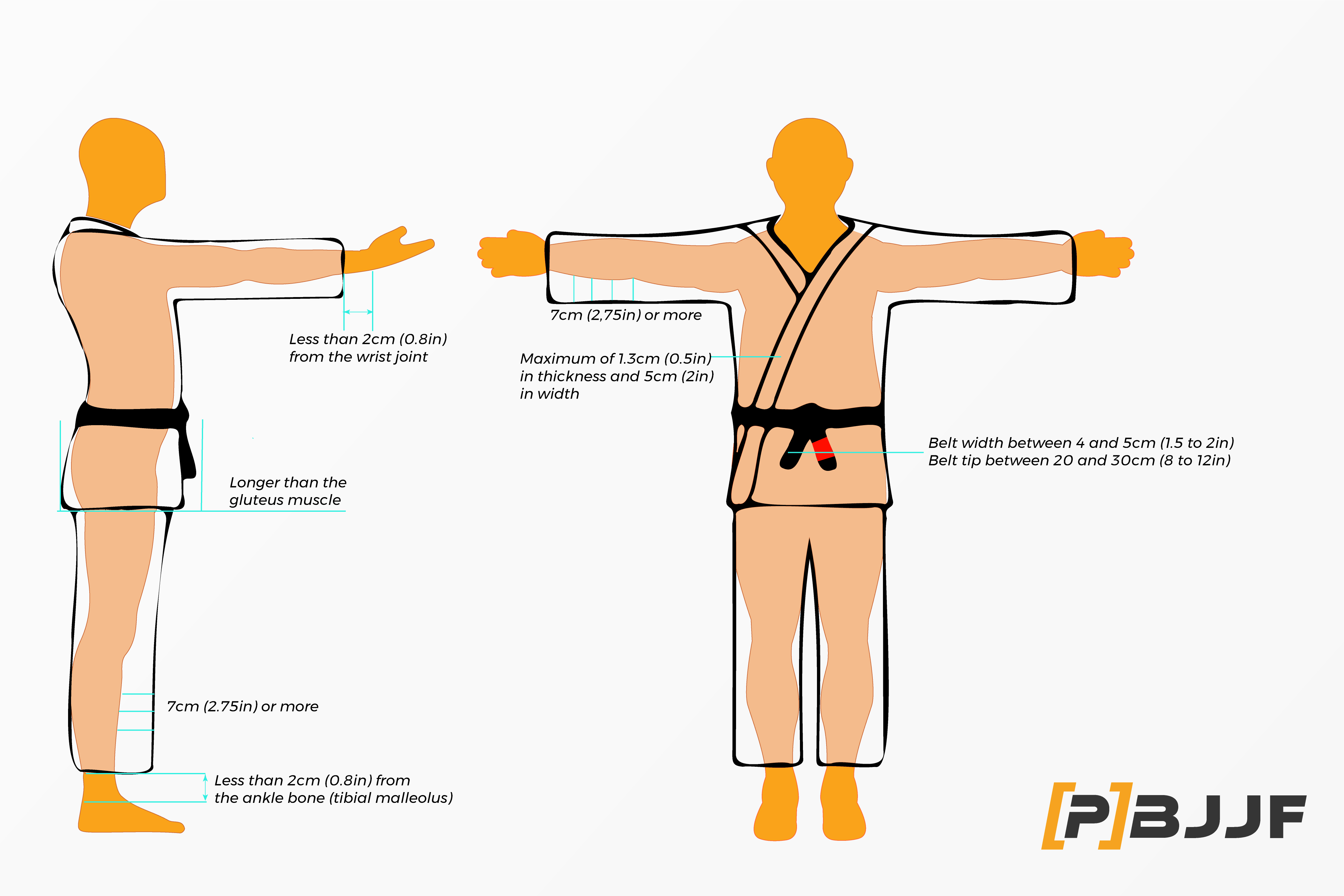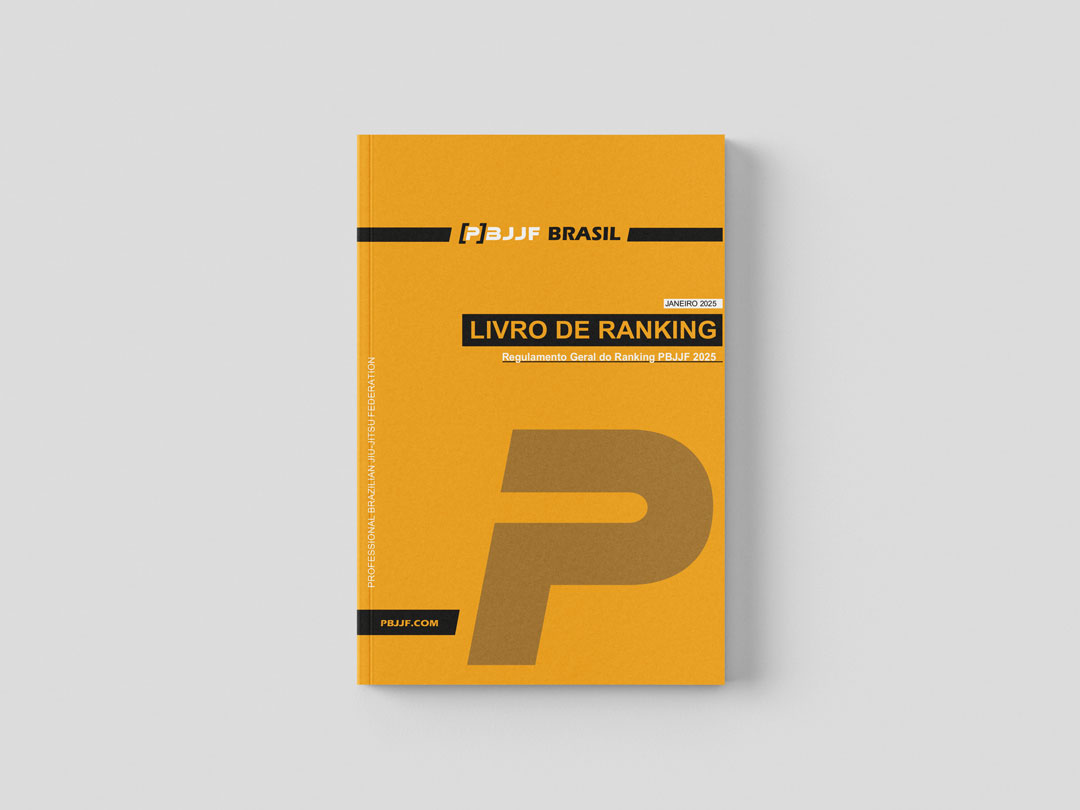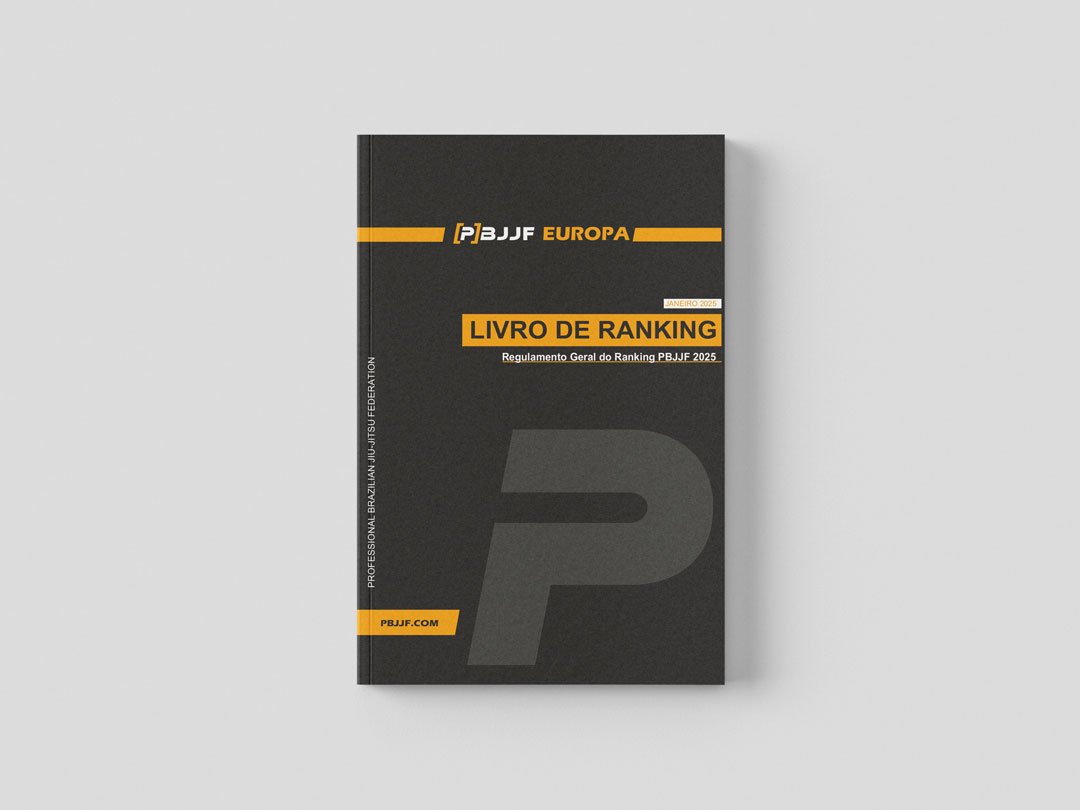DOUBTS? SEND AN EMAIL TO RULES@PBJJF.COM
Uniform Rules
RULES:
1. GI / UNIFORM
1.1 Only white, royal blue, and black Gis are allowed.
1.2 Gi with two colors will not be allowed. No Gi’s will be accepted with different colored jackets or pants, nor will we allow the use of Gis with different colored collars.
1.3 The Gi should be completely white, royal blue or black. No Gi’s will be accepted with different colored jackets or pants nor will we allow the use of Gis with different colored collars.
1.3 If necessary, your Gi will be checked, and you will be required to change it.
1.4 It will not be allowed to wear casual shirt under the Gi and rash guard for male athletes. Female athletes will be allowed to compete wearing only rash guard or sports bras under the Gi.
1.5 Gis may not exhibit mending or tears, be wet or dirty or emanate unpleasant odors.
1.6 For male divisions, wearing pants of any kind under the Gi pants is prohibited. For female divisions, it is permitted for the use of elastic fabric pants (that clings to the body) under the Gi pants, as long as they are shorter than the Gi pants.
1.7 During the weight in, the inspector will verify that the specifications of the uniform meet regulations.
1.8 After the weight in and uniform inspection, athletes may not change their uniform under penalty of disqualification.
2. NOGI / UNIFORM
2.1 For Adults NoGi both genders must wear a shirt of elastic material (skin tight) long enough to cover the torso all the way to the waistband of the shorts, colored black, white, or black and white, and with at least 10% of the rank color(belt) to which the athlete belongs. Shirts 100% the color of the athlete’s rank (belt) are also permitted.
2.2 For Kids NoGi both genders must wear a shirt of elastic material (skin tight) long enough to cover the torso all the way to the waistband of the shorts, colored black, white, or black and white.
Note: For black belts a small red area will be tolerated, but must not decharacterize the athlete’s rank color.
2.3 SHORTS FOR KIDS, MEN AND WOMEN: Board shorts colored black, white, black and white, without pockets or with the pockets stitched completely shut, without buttons, exposed drawstrings, zippers or any form of plastic or metal that could present a risk to the opponent, long enough to cover at least halfway down the thigh, and no longer than the knee.
Also permitted are compression shorts or leggings under the shorts made of elastic material (skin tight) worn beneath the shorts, in the colors black, white, black and white.
For more information about NoGi uniform check the following:
3. Hygiene Rules:
3.1 Athletes’ finger and toenails should be trimmed and short.
3.2 Long hair should be tied up so as not to cause opponents any discomfort.
3.3 Athletes should use footwear up to the match area and wherever their use is permitted.
4. General Requirements:
4.1 Athletes are allowed to weigh in without knee or elbow braces, but they will have to be wearing them at the time of the Gi inspection.
4.2 The athlete cannot step on the scale with shoes or any item besides his/her regular uniform and equipment permitted for use during matches.
4.3 Use of any foot gear, headgear, hair pins, jewelry, cups (genital protectors), or any other protector fashioned of hard material that may cause harm to an opponent or the athlete him/herself is forbidden. Also forbidden is the use of eyes protectors, even if they are made for sports practices.
4.4 The use of joint protectors (knee, elbow braces, etc.) that increase body volume to the point of making it harder for an opponent to grip the Gi are also forbidden.
4.5 It is mandatory that athletes wear undergarments for all competitions, regardless if it is a Gi or No-Gi event. The undergarment should be “brief-type” only. Failure to follow this rule will result in disqualification of the athlete.
TECHNICAL FOULS – ILLEGAL MOVES
Ages / Ranks:
– 4 to 12 years old:
Submission on techniques stretching legs apart
Choke with spinal lock
Straight foot lock
Forearm choke using the sleeves (Ezequiel choke)
Frontal guillotine choke
Omoplata
Triangle (pulling head)
Arm triangle
Lock inside the closed guard with legs compressing kidneys or ribs
Wrist lock
Single leg takedown while the attacking athlete has his head outside his opponent’s body
Bicep slicer
Calf slicer
Knee bar
Toe hold
Heel hook
Locks twisting the knees
Knee Reaping
In straight foot lock, turning in the direction of foot not under attack
In toe hold, applying outward pressure on the foot
Slam
Spinal lock without choke
Scissor takedown
Bending fingers backwards
Grab the opponents belt and throws him to the floor on his head when defending a single leg situation while his opponents head in on the outside of his body
Suplex takedown technique, landing with the opponent’s head or neck on the ground
– 13 to 15 years old
Choke with spinal lock
Straight foot lock
Forearm choke using the sleeves (Ezequiel choke)
Frontal guillotine choke
Omoplata
Triangle (pulling head)
Arm triangle
Lock inside the closed guard with legs compressing kidneys or ribs
Wrist lock
Single leg takedown while the attacking athlete has his head outside his opponent’s body
Bicep slicer
Calf slicer
Knee bar
Toe hold
Heel hook
Locks twisting the knees
Knee Reaping
In straight foot lock, turning in the direction of foot not under attack
In toe hold, applying outward pressure on the foot
Slam
Spinal lock without choke
Scissor takedown
Bending fingers backwards
Grab the opponents belt and throws him to the floor on his head when defending a single leg situation while his opponents head in on the outside of his body
Suplex takedown technique, landing with the opponent’s head or neck on the ground
– 16 & 17 years old (all ranks) and white belts (Adult to Master)
Lock inside the closed guard with legs compressing kidneys or ribs
Wrist lock
Single leg takedown while the attacking athlete has his head outside his opponent’s body
Bicep slicer
Calf slicer
Knee bar
Toe hold
Heel hook
Locks twisting the knees
Knee Reaping
In straight foot lock, turning in the direction of foot not under attack
In toe hold, applying outward pressure on the foot
Slam
Spinal lock without choke
Scissor takedown
Bending fingers backwards
Grab the opponents belt and throws him to the floor on his head when defending a single leg situation while his opponents head in on the outside of his body
Suplex takedown technique, landing with the opponent’s head or neck on the ground
– Adult to Master (blue & purple belts)
Bicep slicer
Calf slicer
Knee bar
Toe hold
Heel hook
Locks twisting the knees
Knee Reaping
In straight foot lock, turning in the direction of foot not under attack
In toe hold, applying outward pressure on the foot
Slam
Spinal lock without choke
Scissor takedown
Bending fingers backwards
Grab the opponents belt and throws him to the floor on his head when defending a single leg situation while his opponents head in on the outside of his body
Suplex takedown technique, landing with the opponent’s head or neck on the ground
– Adult to Master (brown & black belts) exept Adult No Gi
Heel hook
Locks twisting the knees
Knee Reaping
In straight foot lock, turning in the direction of foot not under attack.
In toe hold, applying outward pressure on the foot
Slam
Spinal lock without choke
Scissor Takedown
Bending fingers backwards
Grab the opponents belt and throws him to the floor on his head when defending a single leg situation while his opponents head
Suplex takedown technique, landing with the opponent’s head or neck on the ground.
– Adult (brown & black belts) No Gi
Slam
Spinal lock without choke
Scissor Takedown
Bending fingers backwards
Grab the opponents belt and throws him to the floor on his head when defending a single leg situation while his opponents head
Suplex takedown technique, landing with the opponent’s head or neck on the ground.
* The list of the illegal moves are examples of prohibited techniques and do not represent the full array of prohibited situations and variations.
POINTS SYSTEM
RENDERING DECISION
Match decisions shall be issued in the following forms:
» Submission
» Stoppage
» Disqualification
» Loss of consciousness
» Score
» Referee decision
» Random pick
#Submission
When an athlete taps twice with his/her hand on the opponent, ground, or his/herself in a clear and apparent manner.
When the athlete taps the ground twice with his/her foot, when arms are trapped by opponent.
When the athlete verbally withdraws, requesting the match be stopped.
When the athlete screams or emits noise expressing pain while trapped in a submission hold.
#Stoppage
When one of the athletes alleges to be suffering from cramps, the opponent shall be declared winner of the match.
When the referee perceives that a hold in place may expose the athlete to serious physical injury.
When the doctor deems one of the athletes to be unable to continue a match due to injury rendered by the opponent using a legal hold.
When an athlete presents bleeding that cannot be contained after being treated by the doctor on 2 (two) occa- sions, to which each athlete has the right for each injury and should be provided upon the referee’s request.
When an athlete vomits or loses control of basic bodily functions, with involuntary urination or bowel incontinence.
#Disqualification
illegal moves
#Loss of Consciousness
The athlete shall be declared to have lost the match upon losing consciousness due to a legal hold applied by the opponent or due to an accident not stemming from an illegal maneuver by the opponent.
Note: Athletes who lose consciousness because of head trauma should not be allowed to compete again in the same tournament and should be directed to undergo treatment from medical staff.
#Scoring
The athlete with the most points shall be declared winner when the match has reached regulation time or in the event of the match being stopped due to both athletes suffering injuries.
The referee shall award athletes points according to positions achieved, as shown in the table below.
04 POINTS -MOUNT, BACK MOUNT, BACK CONTROL
03 POINTS – GUARD PASS
02 POINTS – TAKEDOWN, SWEEP, KNEE ON BELLY
Advantages: When there is a draw in the number of points, the athlete with the most advantage points shall be declared the winner.
Penalties: When there is a draw in the number of points and advantage points, the athlete with the least penalty points counted against him/her shall be declared the winner.
****POINTS SCORING
Points shall be awarded by the central referee of a match whenever an athlete stabilizes a position for 3 (three) seconds.
When the proper defensive counter for a submission hold results in exiting the match area, the referee shall signal 2 (two) points be awarded to the athlete applying the submission hold.
Matches should unfold as a progression of positions of technical control that ultimately result in a submission hold. Therefore athletes who voluntarily relinquish a position, in order to again score points using the same position for which points have already been awarded, shall not be awarded points upon achieving the position again.
Athletes who arrive at a point-scoring position while caught in a submission hold shall only be awarded points once they have freed themselves from the attack and stabilized the position for 3 (three) seconds.
Should an athlete achieve point-scoring positions while caught in a submission hold but only escapes the hold once no longer in the point-scoring position, will not be awarded points or advantages for those positions.
The 3-second stabilization count for one or several point-scoring positions will be interrupted, when the opponent lock in a submission hold during the count.
When this happens, the athlete will be awarded an advantage for each of the point-scoring positions achieved, regardless of whether the opponent is no longer in the positions once the hold has been escaped from or regula- tion time has ended.
An athlete who reaches one or more positions (cumulative points) but is being attacked with a submission hold by his/her opponent, shall only be awarded one advantage point if he/she does not escape the attack prior to the end of the match.
Athletes shall be awarded cumulative points when they progress through a number of point-scoring positions, as long as the three-second positional control from the final point-scoring position is a continuation of the positional control from the point-scoring positions from earlier in the sequence. In this case, the referee shall count only 3 (three) seconds of control at the end of the sequence before signaling the points be scored.
Ex: Guard pass followed by mount shall add up 7 points (3+4).When both athletes pull guard at the same time, the athlete who achieves top position first is awarded an
advantage point.
Obs: In cases that the athlete achieves the top position by going straight to the side-mount, he will not receive points nor an advantage for the guard pass.
#Referee Decisions
If at the end of a match both athletes have the same number of points, advantage points and penalties, it is the duty of the referee or referees (when there are three referees overseeing a match) to declare a winner.
To determine the winner, the referee should take note of which athlete displayed greater offense during the match and came closest to achieving possible point- or submission-scoring positions.
#Random Pick
In the event of both athletes suffering accidental injury in a final match where the score is tied at the moment of the accident and neither athlete is able to continue in the contest, the result shall be determined by random pick.
PROFESSIONAL BRAZILIAN JIU-JITSU FEDERATION® 2024




